Brazil is the land of barbecue, but did you know that in Japan there is also Japanese barbecue called yakiniku? What are the differences between Japanese barbecue and Brazilian barbecue?
The word yakiniku refers not only to grilled meat but also to the popular all-you-can-eat restaurants where you can grill your own meat on the grill. We will talk a lot about them in this article.
breaking paradigms - Many believe that meat in japan Yeah man. This article will prove that it is possible to have a barbecue every week in Japan, as we are used to in Brazil. In fact, even easier through the restaurants yakiniku.
Table of Content
The meaning of Yakiniku
The word yakiniku [焼肉] literally means grilled meat [肉], but it is also used to refer to the popular restaurants that have meat as the main dish, whether grilled on the barbecue or on the griddle.
Yaki is an all-encompassing word [焼] and may not have the same concept as a roast or grilled meat. For example, frying meat on the grill can be called Yaki as we do with takoyaki.
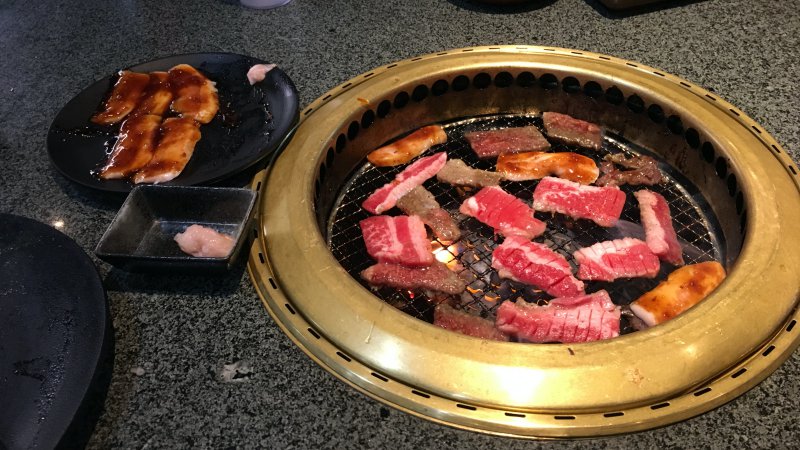
The barbecue in Japanese can also be called the same as in English barbecue [バーベキュー]. The Japanese refer to Brazilian barbecue using the word shurasuko [シュラスコ].
Yakiniku can be defined as a meat in thin and small pieces roasted over a flame of wood charcoal charred by dry distillation, or in a frying pan, gas or electric grill.
How is Japanese barbecue?
Rarely do the Japanese gather in an open place to grill thick pieces of meat on a barbecue. They prefer to go to yakiniku restaurants and grill the meat sliced very thin.
When the Japanese invent roasting meat on a skewer, they prefer to skewer things other than meat. The Japanese eat a lot of meat skewers, but they are usually chicken or pork.
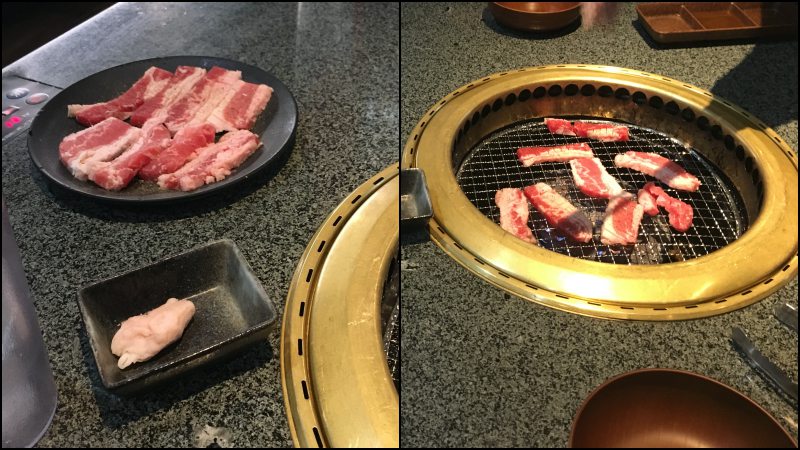
The Japanese prefer rare meat, which is why they cut it very thin in yakiniku restaurants and dip the meat in different sauces. It is a different and delicious experience.
Meat is not seen as much in Japanese dishes other than yakiniku, not because of its price, but simply because of the culture. There was a period when beef was abolished in Japan, which took its place from the table.
Only during the Showa period did Japanese barbecue begin to emerge thanks to the influence of Korean culture and the dishes bulgogui and galbi. After World War II, barbecue was finally popularized in Japan.
How is the Yakiniku restaurant?
There are two different types of restaurant yakiniku. The most popular ones are all-you-can-eat places where customers grill their own meats on grills arranged in the center of a table that accommodates a family.
There are also other restaurants that bear the name yakiniku, but only serve prepared dishes of beef and pork. Once I accidentally went into the wrong restaurant thinking I would get a meat rodízio.

In rodízio restaurants, you usually have access to various types of meat, fish, vegetables, and some even offer desserts, sushi, soba, udon, tempura, crepes, and other dishes, making it a very diverse restaurant.
Some places also often offer unlimited free drinks, or charge a small fee of 100 or 200 yen for them. There are usually days and times when the all-you-can-drink option is cheaper.
The times I went, I paid around 1,500 yen for 2 hours to eat all you want. The first time I found a cheaper place for only 1,000 yen at lunch time.
There you fill your tray with meat and grill it all at your table, as many times as you want. The meat is sliced thin, so it grills in just a few minutes, and you can dip it in a variety of sauces to enhance the flavor.
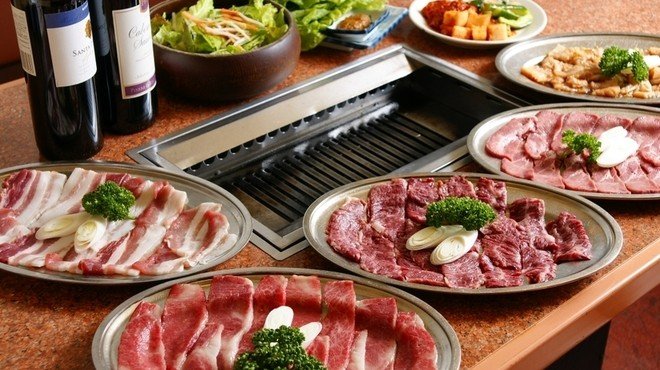
One hour is more than enough for you to be satisfied in a yakiniku restaurant. All this for a lower price than barbecue rodízios in restaurants in Brazil.
In some yakiniku restaurants, you must go to a place to get your meat, but some bring the meat to the table. There are also special meats that need to be ordered from the attendants, or dishes with an additional charge.
types of meat from a yakiniku
At barbecues and yakiniku restaurants, you usually find different types of cuts of beef and pork. It is even possible to eat premium meat like kobe beef and wagyu.
Below we will list some cuts of meat found in a yakiniku, along with other very popular ingredients that accompany this Japanese barbecue.

- Beef:
- Rōsu - loin slices;
- Karubi or baraniku - ribs;
- Harami - soft meat around the diaphragm;
- Tan - tongue meat;
- Misuji - tender meat around the knee;
- Pig:
- Butabara - pork belly;
- P-toro / Tontoro - fatty meat around the face and neck;
- Horumon or motsu - Guts:
- Rebā - beef liver;
- Tetchan - intestine;
- Hatsu - heart;
- Kobukuro - Pig's womb;
- Tēru - Tail slices cut crosswise, with bones;
- Mino / Hachinosu - beef tripe;
- Gatsu - Pig's stomach;
- Chicken;
- Seafood - squid, shellfish, shrimp;
You can also find greens like bell peppers, carrots, mushrooms, onions, eggplant, cabbage, bean sprouts, garlic and kabocha pulp. In fact there are thousands of other cuts not mentioned.
My experience on a Yakiniku
I went on a yakiniku in the city of Hamamatsu, I don't remember its name. I paid 1,000 yen to eat for 2 hours, there were approximately 30 different types of meat. And there was also sushi, tempura, crepe, ice cream and all the other things I already mentioned.
In an hour I could no longer eat. I don't even know what to say, it was a wonderful experience, and everything was delicious, in addition to being super cheap.
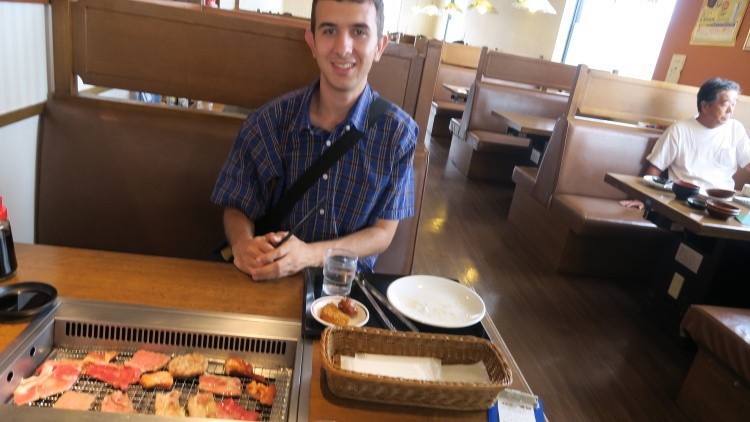
There was still something interesting that happened, I forgot my bag with camera and passport on the spot. I only went back to get it 3 hours later, and it was there as I expected.
Another thing I could observe was a group of four young Brazilians who were at the door of the place, getting in the way. From when I left, and three hours later, when I came back, they were there at the door of the place, sitting on the stairs, getting in the way and bothering people to enter. What is the need?
In Osaka, in Nipponbashi, I also went to a restaurant that had yakiniku in the name. But it was just a regular restaurant, where you choose a dish and that's it. I ordered a super spicy dish and regretted it, but it was tasty.
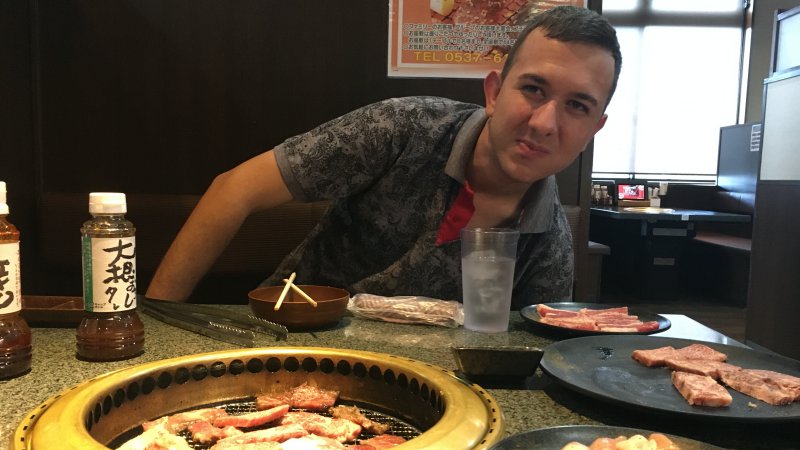
Again, in 2018, during my second trip to Japan, I went three times to a yakiniku. As soon as I met my friend Roberto Pedraça, we went to a yakiniku in Kakegawa; the second time, we returned to the one in Hamamatsu.
In Sapporo, in the province of Hokkaido, I also went to a yakiniku where I had the opportunity to eat the local specialty, the famous sheep meat called Jingisukan.
What did you think of the Japanese barbecue? Have you had the chance to try it? I strongly recommend visiting a yakiniku when you're in Japan.
Thank you for your comments and shares!
